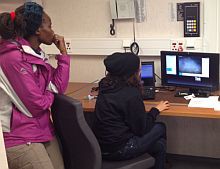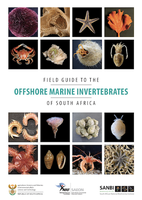Take only photographs, leave only ski-tracks: using underwater photography to sample Sub-Antarctic epi-fauna within an MPA
By Robyn Adams and Charles von der Meden, SAEON Egagasini Node
|
|
This April, SAEON scientists returned to the Prince Edward Islands aboard the research vessel S.A. Agulhas II during its annual relief voyage.
The scientists were there to continue underwater photographic studies of benthic biodiversity and long-term change, started in 2013 in collaboration with Associate Professor Isabelle Ansorge and Prof. George Branch of the University of Cape Town (UCT), Dr Tammy Robinson of Stellenbosch University and the Department of Environmental Affairs (DEA).
Using a towed camera system, the SkiMonkey III, non-destructive photographic sampling of this unique Marine Protected Area (MPA) was conducted so as to compare current ecological patterns with historical data collected by UCT researchers in the 1980s.
Expanding benthic photographic investigations
Team leader Dr Charles von der Meden (SAEON) was joined by Egagasini’s new MSc student, Robyn Adams (The Marine Lab, Stellenbosch University) and DEA scientist Zoleka Filander with the aim of building capacity in deep-sea ecology and expanding benthic photographic investigations.
Both Robyn and Zoleka quickly learned how underwater cameras are not in the same category as your average "point and click” and met first-hand the varied challenges of operating such equipment at sea.
SAEON’s science work was focused on Robyn’s MSc project, aiming to expand benthic sampling to habitat types not sampled in 2013 (rocky and gravel areas), and to investigate links between habitat types, environmental conditions and benthic biodiversity. Through collaboration with the DEA, Zoleka and Charles also launched a pilot study aimed at identifying sites for long-term benthic monitoring.
Explaining aspects of her project, Robyn says, "With your average handheld camera it’s not always easy to take photographs of moving objects, organisms which are minuscule or those excellent at hiding. Sampling using underwater photographs tends to have similar drawbacks in that the assortment of species present in sampled areas can be underrepresented.”
Diverse array of epi-fauna
The new sites sampled this year had a wide variety of substratum types and subsequently held a diverse array of epi-fauna, including large basket stars which were not seen during the 2013 cruise.
Photographs from a range of sites will be used to determine the optimal number of photographs needed to obtain an accurate depiction of the diversity present, with respect to the type of habitat sampled. The reasoning behind this is that depth, substrate type and productivity (i.e. benthic food sources) may all affect species diversity in an area.
Robyn also points out that photographs are beneficial in that snapshots of species-species interactions can be viewed and captured in real time. A good example of this seen during the cruise was the common occurrence of brittle stars (Astrotoma agassizi) sharing space with feather stars at the summit of the colourful octocorals.
Towards long-term benthic sampling and monitoring
With optimised sampling procedures and a more complete range of habitats sampled, Charles together with Dr Lara Atkinson (SAEON), will be able to use comparisons with historical data to the fullest in investigating long-term change in benthic biodiversity at the islands, and hope that through the collaborative effort with DEA, long-term benthic sampling and monitoring can be developed to aid our understanding of this pristine system.
The team is sincerely grateful for the efforts of DEA technician Mr Mfundo Lombi, the captain and crew of the SA Agulhas II, and the Chief Scientist, Dr Hans Verheye (also DEA).
















